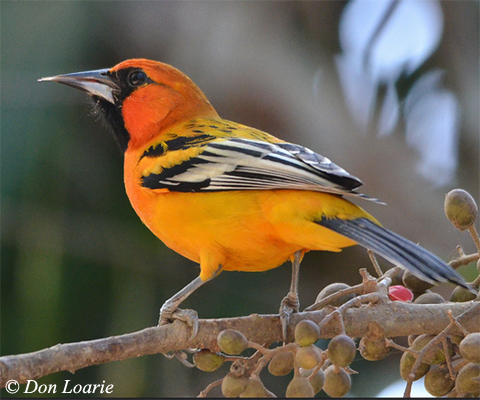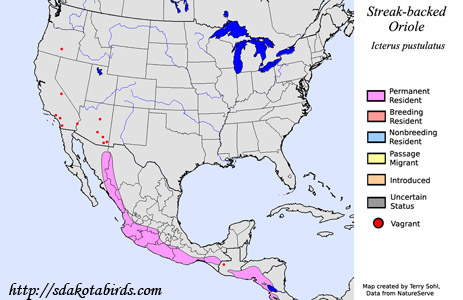Streak-backed Oriole
Icterus pustulatus
| Length: 8 inches | Wingspan: 13 inches | Seasonality: Non-resident in South Dakota |
| ID Keys: (males) Broken streaks on upper back, head obviously deeper orange than orange body | ||
 The
Streak-backed Oriole is a bird of Mexico and Central America, but a few
sometimes stray into southern Arizona and California, primarily in the fall
and winter. However, there are a few records of breeding in the U.S.
Streak-backed Orioles are distinguished by the broken dark streaks on an
orange back, and a darker orange on their head than on the rest of their
body. In the northern part of their range, including those birds that cross
into the U.S., males are much more brilliantly colored than females, as is
common with most Orioles. However, females are progressively brighter
as you move southward in the species' range, so much so that in the southern
part of their range they are sometimes difficult to distinguish from males.
The
Streak-backed Oriole is a bird of Mexico and Central America, but a few
sometimes stray into southern Arizona and California, primarily in the fall
and winter. However, there are a few records of breeding in the U.S.
Streak-backed Orioles are distinguished by the broken dark streaks on an
orange back, and a darker orange on their head than on the rest of their
body. In the northern part of their range, including those birds that cross
into the U.S., males are much more brilliantly colored than females, as is
common with most Orioles. However, females are progressively brighter
as you move southward in the species' range, so much so that in the southern
part of their range they are sometimes difficult to distinguish from males.
Habitat: They are usually found in open woodlands and semi-arid shrublands. In much of their range their prefer open woodlands with thorny Mimosa shrubs in the undergrowth. They also seem to prefer areas of other thorny bush species when Mimosa is not present.
Diet: Feeds heavily on insects and spiders, but will also eat fruits, berries, seeds, and nectar.
Behavior: Tends to forage at moderate to high elevations in the canopy of broad-leaf forests.
Nesting: Monagamous during the nesting season, a female builds a hanging, basket-shaped nest from plant figures, typically near the end of a tree branch. The clutch usually consists of 3 or 4 eggs, which hatch after about 2 weeks. The young are fed by both parents, with the fledging occurring after about 2 weeks.
Song: Males sing a warbling ooo-CHEE-ooo-CHEE-ooo-CHEE-ooo
Migration: Considered a permanent resident throughout its range, some short distance migration is noted, as evidenced by birds moving to the southwestern U.S. in fall and winter.
Interactive eBird Map: Click here to access an interactive eBird map of Streak-backed Oriole sightings
Similar Species: In range, most likely to be confused with Hooded Warbler
Conservation Status: Populations are considered stable, and the IUCN lists the Streak-backed Oriole as a species of "Least Concern"
Further Information: 1) Cornell's Neotropical Birds - Streak-backed Oriole
2) BirdFellow - Streak-backed Oriole
3) Beauty of Birds - Streak-backed Oriole
Photo Information: Photo taken by Don Loarie - Photo licensed under Creative Commons Attribution-NonCommercial-ShareAlike 2.0 Generic License
| Click below for a higher-resolution map |
 |
| South Dakota Status: Non-resident in South Dakota |
Additional Streak-backed Oriole Photos (Coming soon...)
